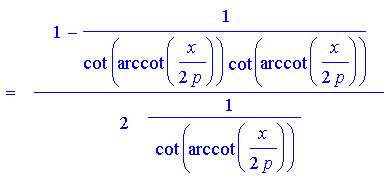Proof that Parabolic Reflectors Work
Here is a proof that any paraboloid will work as a reflecting
antenna, focusing incoming rays which are parallel to the axis of symmetry to a
point. I have included Maple plots of a particular parabola,  , but the proof embraces all parabolas. The plots
will be helpful in visualizing our plan of attack.
, but the proof embraces all parabolas. The plots
will be helpful in visualizing our plan of attack.
We see below that a certain incoming vertical ray,  , impinges upon the parabola at the point (
, impinges upon the parabola at the point ( ) and forms an angle,
) and forms an angle, , with the line tangent to the curve at the point of incidence. The reflected
ray is
, with the line tangent to the curve at the point of incidence. The reflected
ray is  . We will assume that the angle of
reflection is equal in measure to the angle of incidence. This is a sound
assumption but, more to the point, it has nothing to do with paraboloids and so
does not detract from the value of this proof. We have indicated this congruence
in the diagram below.
. We will assume that the angle of
reflection is equal in measure to the angle of incidence. This is a sound
assumption but, more to the point, it has nothing to do with paraboloids and so
does not detract from the value of this proof. We have indicated this congruence
in the diagram below.

Our task is to show that ray  proceeds from the point of reflection to the
parabolas' focus. It is not enough for us to simply demonstrate this truth for a
set of selected incoming rays and a selection of parabolas, which is what we did
with our Maple program. The diagram above is such an illustrative example,
showing a particular ray striking a particular point on a particular parabola.
Our proof must apply to all incoming rays parallel to the axis of symmetry and
all parabolas. The proof is straightforward.
proceeds from the point of reflection to the
parabolas' focus. It is not enough for us to simply demonstrate this truth for a
set of selected incoming rays and a selection of parabolas, which is what we did
with our Maple program. The diagram above is such an illustrative example,
showing a particular ray striking a particular point on a particular parabola.
Our proof must apply to all incoming rays parallel to the axis of symmetry and
all parabolas. The proof is straightforward.
We begin with the formula for a vertically orientated parabola
with its vertex on the origin, without derivation:

Here p is the location of the focus. We note that an
incident ray strikes the parabola at a point we call (x, y). The
slope of the parabola at that point is the derivative

From trigonometry we know that
 ,
,
and that the slope of  is
is

(invoking the vertical angle theorem). This is true if the ray
strikes above the focus, as in the first diagram, or below it, as illustrated
here.

We want to show that a ray drawn from point (x,
y) with slope cot(2*arccot(x/2p)) will intersect
point (0, p). Ohhkkaaayyyy...
Note that the slope of a line passing through (x,
y) and (0, p) can be expressed as the familiar "rise over run"
ratio:



For our ray,  , to include
point p, these two expressions for the slope must be equal. So our proof
will be complete if we can show that
, to include
point p, these two expressions for the slope must be equal. So our proof
will be complete if we can show that

We decide to work on the right side of this conjecture to
reduce it to the expression on the left. But first, we utilize Maple to plot
both functions of x in order to check our logic.

Both functions produced the same plot (above). This
encouragement was key to my quick success: it gave me confidence, (I love
Maple).
We will rely on the following identities:
(1) cot(x) = 1/tan(x),
(2) tan(2x) = 2*tan(x)/(1 -
tan^2(x)),
Beginning with our trigonometric expression
for the slope of 

we utilize (1)
and (2) to obtain
 .
.
Expanding and applying (1) we have

which reduces immediately to

and
 A little algebra yields
A little algebra yields

and finally

as we hoped. We have shown that a ray drawn
from point (x, y) with slope
cot(2*arccot(x/2p)) will intersect point (0, p).
Hence, any paraboloid will work as a reflecting antenna, focusing incoming rays
parallel to the axis of symmetry, to a point. QED
Click here
for more information on parabolic reflectors